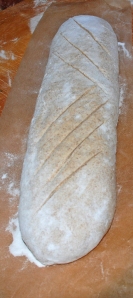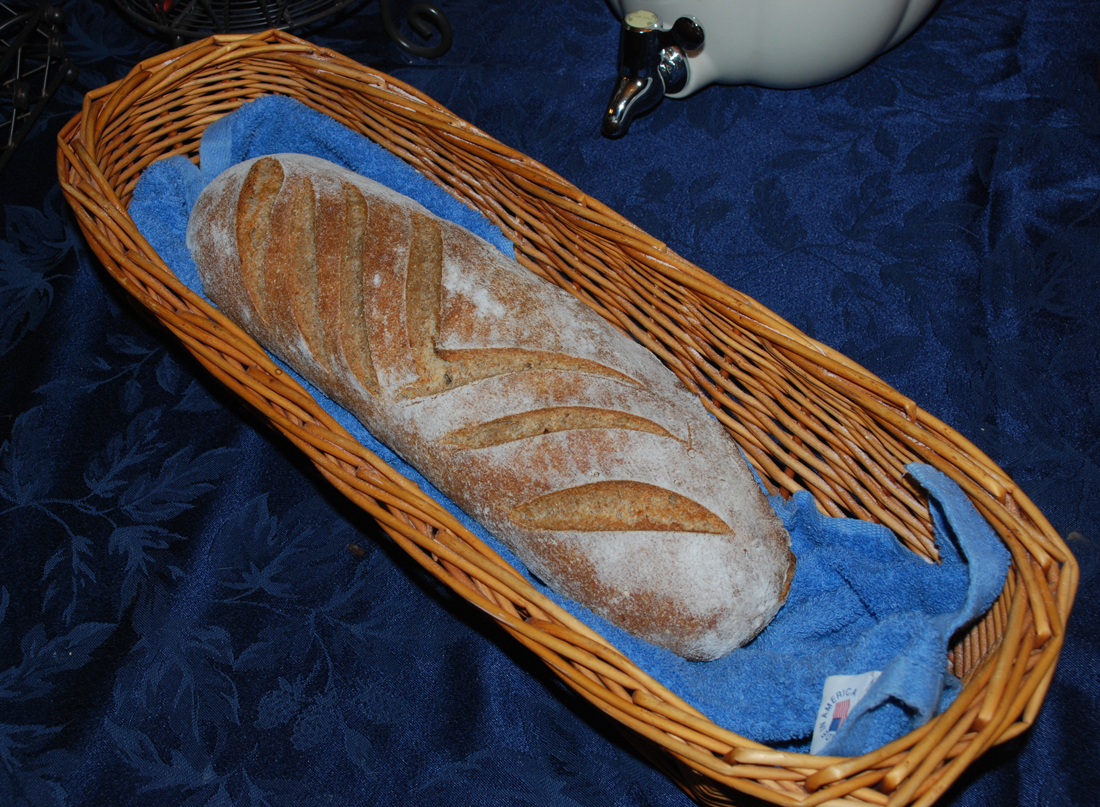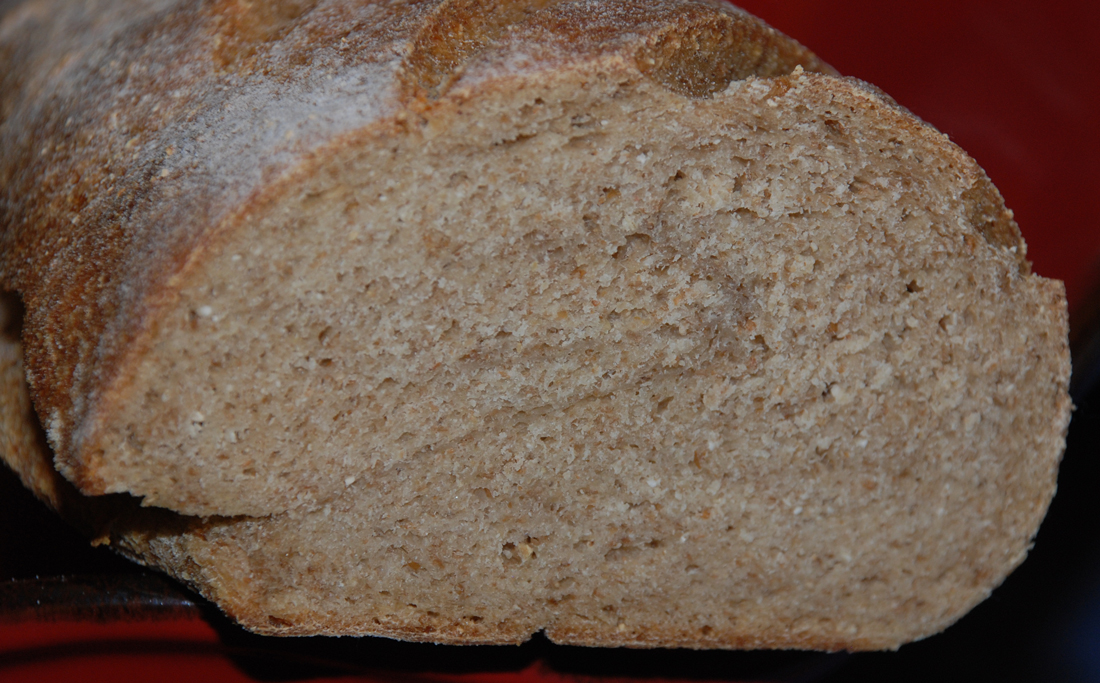 It's great to be back home from my 11 day trip to China for business. I couldn't wait to get home to my wife and my 5 kitty cats. We recently adopted another furball named Cleopatra and she has lived up to her name taking over the household like she's been with us forever.
It's great to be back home from my 11 day trip to China for business. I couldn't wait to get home to my wife and my 5 kitty cats. We recently adopted another furball named Cleopatra and she has lived up to her name taking over the household like she's been with us forever.
Anyway, I was chomping at the bit to bake some bread so after refreshing my starter I decided to make a simple sourdough Pain Au Levain, but of course I needed to add something different to the formula to make it a bit more interesting.
I had recently purchased some coconut flour from Whole Foods and decided to try adding some to this concoction and see what happens. I also added some wheat germ, Durum flour and pumpernickel flour along with bread flour. The levain starter was made with my standard 65% AP starter along with some whole wheat and bread flour. I also added some dried toasted onions which I rehydrated in the water used for the dough.
The resulting dough turned out very interesting with a nice nutty flavor but a bit dense. The coconut flour really soaks up the water and in hindsight I should have uppped the hydration level of this bread even though it is already 71%.
Starter (Levain)
71 Grams Seed Starter (65% AP Starter)
142 Grams Bread Flour
85 Grams Whole Wheat Flour
151 Grams Water (90 Degrees F.)
Final Dough
458 Grams Levain from Above
260 Grams Bread Flour
65 Grams Pumpernickel Flour
75 Grams Coconut Flour
25 Grams Durum Flour
35 Grams Toasted Wheat Germ
17 Grams Sea Salt
4 Grams Toasted Dried Onions
15 Grams Walnut Oil (You can substitute your oil of choice)
336 Grams Water, 90 degrees F. (Note: If you want a more open crumb I would increase the water another 15 - 20 grams)
Directions
Levain
Combine the ingredients for the Levain and mix by hand or in your mixer for 1-2 minutes. Place it in a covered glass or plastic bowl and let it sit for 9-10 hours at room temperature. If you are ready to bake you can use it immediately, otherwise you can refrigerate it for at least 1-2 days.
Final Dough
For the final dough, using your stand mixer or by hand, mix the water with the Levain to break it up.
Add the toasted onions to re-hydrate them in the water and then add the flours and oil and mix on the lowest speed for 2 minutes. Let rest for 15 minutes.
Now add the salt and mix for 4 minutes more on medium speed, adding more flour if necessary to produce a slightly sticky ball of dough.
Remove dough to your lightly floured work surface and knead for 1 minute and form into a ball.
Leave uncovered for 15 minutes.
Do a stretch and fold and form into a ball again and cover with a clean moist cloth or oiled plastic wrap.
After another 15 minutes do another stretch and fold and let it rest again for another 10 - 15 minutes. Do one last stretch and fold and then put it into a lightly oiled bowl that has enough room so the dough can double overnight.
Let the dough sit in your bowl for 2 hours at room temperature. It should only rise slightly at this point. After the 2 hours are up put in your refrigerator for at least 12 hours or up to 3 days.
When ready to bake the bread take your bowl out of the refrigerator and let it sit at room temperature for around 2 hours. After 2 hours shape the dough as desired being careful not to handle the dough too roughly so you don't de-gas it.
Place it in your bowl, banneton or shape into baguettes. I used my new banneton I found in a thrift store and made one large loaf.
Let it sit at room temperature for 2 hours covered with oiled plastic wrap or a moist cloth.
Pre-heat oven with baking stone (I use one on bottom and one on top shelf of my oven), to 500 degrees F.
Slash loaves as desired and place empty pan in bottom shelf of oven.
Pour 1 cup of boiling water into pan and place loaves into oven.
Lower oven to 450 Degrees and bake for 25 - 35 minutes until bread is golden brown and internal temperature reaches 200 degrees.
Shut the oven off and leave the bread inside with the door slightly open for 10 minutes. This will help dry the loaves out and keep the crust crunchy.
Let cool on cooling rack and enjoy!
Feel free to see some of my older posts at my other blog: www.mookielovesbread.wordpress.com
- Isand66's Blog
- Log in or register to post comments



That's a beautiful loaf, isand66.
I've seen coconut flour in the health foods store I patron.
Not cheap, that's for sure!
Have done a bit of research and found that it's 4x more absorbent than wheat flour. It's a sponge's sponge.
Considering you didn't adjust hydration, I'm surprised your loaf didn't turn into a stone.
So did it taste like coconut? Even just a hint?
Thanks Thomas. I found a small bag of Coconut flour in a specialty store and it actually wasn't too expensive, around $6 USD so I figured it was worth a try.
You are right about the sponge effect. I actually had added 24 grams of extra water while mixing the dough but in hindsight another 15-25 grams would have helped open up the crumb. Since this bread has whole wheat, durum, pumpernickel and bread flour along with the coconut flour the overal result ended up with almost a sweet tasting rye bread. There is a hint of the coconut but not as much as I would have hoped. If you try this you may want to bump up the % of coconut or maybe even try adding some coconut milk instead of the water.
Anyway, thanks again for your comments they are appreciated.
Regards,
Ian
Well, i guess i have to bookmark your bread Isand!
Nice bread, i particuarly like the slashing effect that you made. It's new and inspiring.
I'm trying to imagine the aroma of the bread while baking, and the flavor...i guess i have to make it at a certain point.
Very well done man :-)
Izzat
Thanks Izzat for your kind words.
It ended up with a nice subtle coconut flavor coupled with the rye flour and other ingredients.
If you try it, do bump up the water as I think that will definitely improve it even more.
Let me know if you ever give it a go.
Regards,
Ian
I noticed that your bread hydration is around 71%, so do you think i should make it like say 73-75%?
Sure, the coconut tends to absorb water very greedily.
I'm trying to imagine how this bread would taste with butter and some strawberry or cherry jam...hmmmm :)
I would say 75% would probably be perfect!
It makes real good toast for sure.
Ian
fancy doo slashes of yours on this fine looking loaf of bread. Coconut flour in bread is a new one for me. I saw it at WF but thought it was possibly for pastry making of some kind - like coconut cake? Leave it to you to put it good use in bread. If it sucks up water 4 times more than wheat, I bet 80% hydration would work out OK with the extra coconut flour (to get more coconut taste that you want) and with all the WW and pumpernickel too. Maybe do S &F's on a floured surface to compensate? It's easier to add four than water for sure :-)
I would like to taste it so will have to make some.
Bake On Ian
Thanks DA...I actually enjoy working with wet doughs so next time I will bump up the water and give it a go.
Best...Ian
That is a very pretty looking loaf Ian and you timed your proofing to perfection because the scoring has opened perfectly. An interesting combination of ingredients, too. Did you eat any bread in China? What was your favourite? What didn't you like? What other foods did you enjoy?
Nice baking,
Syd
Thanks for your kind words Syd.
Unfortunately most of the places I stay in China do not have the best cuisine and the bread quality was sorely lacking. Bread is not a common side dish in Chinese meals. I have had a desert bread several times which is similar to a bun that is dipped in a sweet condensed milk type sauce. The bread itself is very doughy and plain tasting, not my cup of tea. The best bread I have had was a bun filled with diced pork and onions which was so good my hosts ordered more so we could eat some with lunch the next day. I shall have to take some photos of that one the next time I had it.
On this last trip we went to a Thai restaurant that was real good, and probably one of the best meals I had on my trip. Most of the time I am staying in small cities that don't have the best cuisine so this place was a treat. We had some Nan bread with onion inside that came out nice and hot. We had ordered some chopped beef with onions and spicy peppers that you are supposed to eat with lettuce wraps but I found the Nan bread to be the ideal accompaniment. Here is a photo from the meal.
Thanks again for the comments.
Ian
t.
I love the scoring you did on this loaf. I now have a new pattern to try :-)
I didn't know there was such a thing as coconut flour.....I do use coconut oil in place of butter in a lot of my loaves now and I love it. I also use coconut milk to make a great chocolate ice cream for my kids.....and now I will have to check out coconut flour :-)
Thanks for the new ideas!
Janet
Thanks Janet!
I do hope you give it a try.
Since I made such a big loaf I was able to give this one a try and was very happy with the end result.
I want to try using some coconut milk in a bread one day and see how that effects the flavor. The flour only gives it a very subtle flavor, but maybe if I use a more neutral flour mix it may be more noticeable.
I like the idea of using the coconut oil so I will have to try and pick some of that up as well. I have pistachio nut and walnut oil so coconut would make a good addition!
Regards,
Ian
Ian,
Shop around for the coconut oil as the prices really vary. I am fortunate in that I get mine from the woman from whom I buy my grains and she gets a really good deal by buying in bulk. I pay 40.00 for a gallon and it is organic.
Take Care,
Janet
Thanks Janet.
I don't think I'm ready for a gallon if it so hopefully I can find a smaller amount.
Regards
Ian
Pretty scroring, and I'm intrigued by the coconut- very inspiring!
Thanks Flour Child. Appreciate the comment.
Regards
Ian
Such an inventive mixture of flours, Ian! Lovely, and welcome back! The bread does look beautiful, but what about the flavor? would you describe it?
Thanks Kalid.
I'm actually eating a piece toasted right now for breakfast with some cheese.
It actually has a very slight hint of coconut, but if you didn't know I used coconut flour you wouldn't know what it was.
It tastes almost like a cocktail rye bread with a slightly sweet flavor from the coconut.
Regards,
Ian